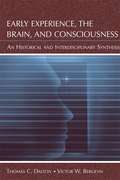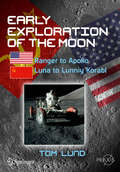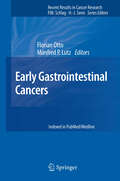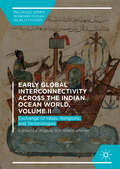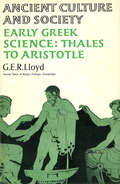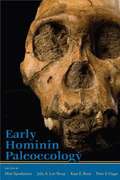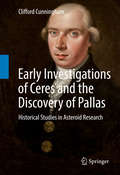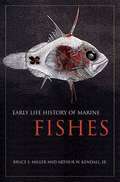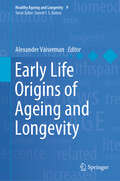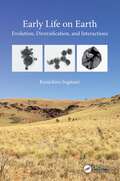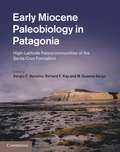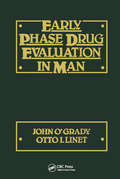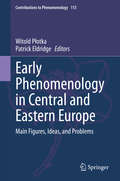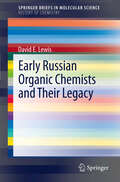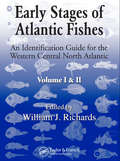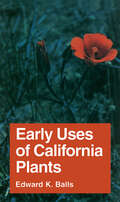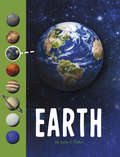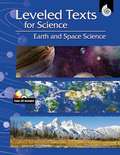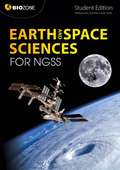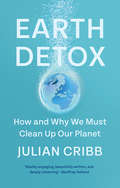- Table View
- List View
Early Experience, the Brain, and Consciousness: An Historical and Interdisciplinary Synthesis
by Thomas C. Dalton Victor W. BergennThis new book examines the interrelationship between neuroscience and developmental science to help us understand how children differ in their capacity to benefit from their early motor and cognitive experiences. In so doing, it helps us better understand how experience affects brain growth and a childs capacity to learn. In this interdisciplinary
Early Exploration of the Moon: Ranger to Apollo, Luna to Lunniy Korabl (Springer Praxis Books)
by Tom LundLuna 2, launched by the USSR in 1959, was the first spacecraft from Earth to land on the moon. That first voyage was followed by increasingly capable lunar exploration spacecraft from Russia and the United States. A total of 36 successful lunar exploration missions were conducted from 1959 to the last Apollo manned exploration in 1972 and the final travels of the Lunokhod lunar rover in 1973. Of all the missions, that of Apollo 17 was the pinnacle of manned space exploration. Apollo 17 astronauts traveled 21 miles on the lunar surface in a dune buggy-type vehicle, stopping frequently to explore and gather samples.The spacecraft that enabled lunar exploration were ingenious, and reflected the best efforts of talented people working with the technology of the day. This book showcases the engineering involved in those incredible machines. The spacecraft covered, and their missions, are listed below.From the United States:• Ranger – Photography en route to lunar impact• Lunar Orbiter – Photography of front and back side of moon• Surveyor – Soft landing, photography, and soil analysis• Apollo – Manned exploration. Lunar Rover expanded range From the USSR:• Luna 2 – Photography en route to lunar impact• Luna 3 – Photography of back side of moon on flyby• Luna 9 and 13 – Soft landing, photography, and soil analysis• Luna 10, 11, 12, 14 – Photography from lunar orbit• Luna 16, 20, 24 – Soft landing, return of soil sample to Earth• Lunokhod-1, -2 – Lunar roving vehicle driven from Earth• L1 – Planned manned lunar flyby but only flew unmanned• L3 – Planned manned lunar landing but never flew to moon To tell the story of these spacecraft, Tom Lund draws on over 40 years’ work on aircraft and spacecraft systems. He was technical lead for the landing radars for the Surveyor and Apollo spacecraft, and his practical experience is augmented by master’s degrees in electrical engineering, physics, and business administration.
Early Flowers and Angiosperm Evolution
by Kaj Raunsgaard Pedersen Peter R. Crane Else Marie FriisThe recent discovery of diverse fossil flowers and floral organs in Cretaceous strata has revealed astonishing details about the structural and systematic diversity of early angiosperms. Exploring the rich fossil record that has accumulated over the last three decades, this is a unique study of the evolutionary history of flowering plants from their earliest phases in obscurity to their dominance in modern vegetation. The discussion provides comprehensive biological and geological background information, before moving on to summarise the fossil record in detail. Including previously unpublished results based on research into Early and Late Cretaceous fossil floras from Europe and North America, the authors draw on direct palaeontological evidence of the pattern of angiosperm evolution through time. Synthesising palaeobotanical data with information from living plants, this unique book explores the latest research in the field, highlighting connections with phylogenetic systematics, structure and the biology of extant angiosperms.
Early Gastrointestinal Cancers
by Florian Otto Manfred P. LutzThis Recent Results in Cancer Research volume contains the majority of the invited expert contributions from the First St. Gallen EORTC Gastrointestinal Cancer Conference, held on 22-24 March 2012 in St. Gallen, Switzerland. Written by some of the world's leading experts in the field, the volume constitutes a comprehensive update on recent developments in the imaging, molecular biology, pathology, and multidisciplinary management of early cancer of the gastrointestinal tract. The latest recommendations regarding diagnosis and treatment are provided, and areas of consensus and controversy, identified. While the principal focus is on esophageal and gastric cancer, advances in the treatment of colorectal and pancreatic cancer are also discussed in some detail. This book will be of interest to every clinician involved in the care of patients with gastrointestinal malignancies.
Early Global Interconnectivity across the Indian Ocean World, Volume II: Exchange of Ideas, Religions, and Technologies (Palgrave Series in Indian Ocean World Studies)
by Angela SchottenhammerThis volume investigates the emergence and spread of maritime commerce and interconnectivity across the Indian Ocean World—the world’s first “global economy”—from a longue durée perspective. Spanning from antiquity to the nineteenth century, these essays move beyond the usual focus on geographical sub-regions or thematic aspects to foreground inter- and trans-regional connections. Focusing on the role of religion in the expansion of commerce and exchange across the region, as well as on technology and knowledge transfer, volume II covers shipbuilding and navigation technologies, porcelain production, medicinal knowledge, and mules as a commodity and means of transportation.
Early Greek Science: Thales to Aristotle
by Dr G E LloydIn this new series leading classical scholars interpret afresh the ancient world for the modern reader. They stress those questions and institutions that most concern us today: the interplay between economic factors and politics, the struggle to find a balance between the state and the individual, the role of the intellectual. Most of the books in this series centre on the great focal periods, those of great literature and art: the world of Herodotus and the tragedians, Plato and Aristotle, Cicero and Caesar, Virgil, Horace and Tacitus.This study traces Greek science through the work of the Pythagoreans, the Presocratic natural philosophers, the Hippocratic writers, Plato, the fourth-century B.C. astronomers and Aristotle. G. E. R. Lloyd also investigates the relationships between science and philosophy and science and medicine; he discusses the social and economic setting of Greek science; he analyses the motives and incentives of the different groups of writers.
Early Greek Science: Thales to Aristotle (Ancient Culture and Society)
by G. E. R. LloydG. E. R. Lloyd also investigates the relationships between science and philosophy and science and medicine; he discusses the social and economic setting of early Greek science; and he analyzes the motives and incentives of the different groups of writers.
Early Hominin Paleoecology
by Julia A. Lee-Thorp Kaye E. Reed Matthew Sponhiemer Peter UngarAn introduction to the multidisciplinary field of hominin paleoecology for advanced undergraduate students and beginning graduate students, Early Hominin Paleoecology offers an up?to?date review of the relevant literature, exploring new research and synthesizing old and new ideas.Recent advances in the field and the laboratory are not only improving our understanding of human evolution but are also transforming it. Given the increasing specialization of the individual fields of study in hominin paleontology, communicating research results and data is difficult, especially to a broad audience of graduate students, advanced undergraduates, and the interested public. Early Hominin Paleoecology provides a good working knowledge of the subject while also presenting a solid grounding in the sundry ways this knowledge has been constructed. The book is divided into three sections--climate and environment (with a particular focus on the latter), adaptation and behavior, and modern analogs and models--and features contributors from various fields of study, including archaeology, primatology, paleoclimatology, sedimentology, and geochemistry.Early Hominin Paleoecology is an accessible entrée into this fascinating and ever-evolving field and will be essential to any student interested in pursuing research in human paleoecology.
Early Investigations of Ceres and the Discovery of Pallas
by Clifford CunninghamAn asteroid scholar, Cunningham in this book picks up where his Discovery of the First Asteroid, Ceres left off in telling the story of the impact created by the discovery of this new class of object in the early 1800s. The best and brightest minds of mathematics, science, and philosophy were fascinated by Ceres, and figures as diverse as Gauss, Herschel, Brougham, Kant, and Laplace all contributed something to the conversation. The first few chapters deal with the mathematical and philosophical aspects of the discovery, and the rivalry between Germany and France that so affected science and astronomy of that era. The jockeying for glory over the discovery of Ceres by both Piazzi and Bode is examined in detail, as is the reception given to Herschel's use of the word 'asteroid. ' Archival research that reveals the creator of the word 'asteroid' is presented in this book. Astronomy was a truly cosmopolitan field at the time, spanning across various disciplines, and the discovery of Pallas, a story completely told in these pages, exemplifies the excitement and drama of early 1800s astronomy. All the private correspondence about the study of Ceres and Pallas in 1802 is given here, which helps to contextualize and personalize the discovery.
Early Life History of Marine Fishes
by Bruce S. Miller Arthur W. KendallThe life cycles of fishes are complex and varied, and knowledge of the early life stages is important for understanding the biology, ecology, and evolution of fishes. In Early Life History of Marine Fishes,Bruce S. Miller and Arthur W. Kendall Jr. , bring together in a single reference much of the research available and its application to fishery science--knowledge increasingly important because, for most fishes, adult populations are determined at the earliest stages of life. Clear and well written, this book offers expert guidance on how to collect and analyze larval fish data and on how this information is interpreted by applied fish biologists and fisheries managers.
Early Life Origins of Ageing and Longevity (Healthy Ageing and Longevity #9)
by Alexander VaisermanThis book provides a comprehensive overview of the field of developmental programming of ageing phenotypes. Although gerontological research has traditionally focused on later stages of the life cycle, growing evidence indicates that both the rate of ageing-associated functional declines, and the risks of later-life chronic pathological conditions, can be traced to origins early in life. While other books in the field concentrate on the developmental origin of particular disorders, this volume offers a detailed guide to all important aspects of the role of early-life conditions in programming both chronic pathological conditions and the ageing process.Interest in the study of ageing and longevity had its beginnings in research on the fetal origins of adult disease. This has evolved into a hypothesis on the Developmental Origins of Adult Health and Disease (DOHaD), which postulates that adverse environmental exposures during critical in-utero and early postnatal stages of development may permanently change physiological responses and cause functional impairments and disorders in adult life. In this book, the contributing authors and leading experts from around the world, describe research on mechanisms underlying the developmental programming phenomenon, as well as interventional strategies aimed at restoring developmentally disrupted epigenetic patterns. Early Life Origins of Ageing and Longevity benefits a wide audience of working scientists, clinicians, and advanced students, and will also interest scientifically curious general readers who wish to know more about current research in this rapidly evolving field.
Early Life on Earth: Evolution, Diversification, and Interactions
by Kenichiro SugitaniThis book comprehensively explores the early evolution of life and the Archean environment. Topics include the differences between prokaryotes and eukaryotes, variations in metabolisms, concepts of ecosystems and biogeochemical cycles (nitrogen, sulfur, phosphorous), Archean geology and environments, and the widely accepted early evolutionary history of life. The text addresses controversies regarding early life and its environment, particularly the unusual microfossil assemblages from the 3.4 Ga Strelley Pool Formation and the 3.0 Ga Farrel Quartzite of Western Australia. Readers will get a fuller picture of the Archean world, and an appreciation of many still unresolved questions. Key Features Illustrated with figures visualizing ecosystems, biogeochemical cycles etc which are indispensable for understanding the Archean Earth. Includes tables arranging key words, definitions, and interpretations. Documents the Archean environment with photographic evidence and detailed descriptions the rocks, minerals and microfossils. Summarizes the latest field research. Details exciting unresolved questions for future study.
Early Miocene Paleobiology in Patagonia
by Sergio F. Vizcaíno Richard F. Kay M. Susana BargoCoastal exposures of the Santa Cruz Formation in southern Patagonia have been a fertile ground for recovery of Early Miocene vertebrates for more than 100 years. This volume presents a comprehensive compilation of important mammalian groups which continue to thrive today. It includes the most recent fossil finds as well as important new interpretations based on 10 years of fieldwork by the authors. A key focus is placed on the paleoclimate and paleoenvironment during the time of deposition in the Middle Miocene Climatic Optimum (MMCO) between 20 and 15 million years ago. The authors present the first reconstruction of what climatic conditions were like and present important new evidence of the geochronological age, habits and community structures of fossil bird and mammal species. Academic researchers and graduate students in paleontology, paleobiology, paleoecology, stratigraphy, climatology and geochronology will find this a valuable source of information about this fascinating geological formation.
Early Nineteenth Century Chemistry and the Analysis of Urinary Stones (Perspectives on the History of Chemistry)
by E. Allen DriggersThis book tells the story of how chemists, physicians, and surgeons attempted to end the problem of urinary stones. From the late eighteenth to the early nineteenth centuries, chemists wanted to understand why the body formed urinary, pancreatic, and other bodily stones. Chemical analysis was an exciting new means of understanding these stones and researchers hoped of possibly preventing their formation entirely. Physicians and surgeons also hoped that, with improved chemical analysis, they would eventually identify substances that would reduce the size of stones, leading to their easier removal from the body. Urinary stones and other stones of the body caused the boundaries of surgery, chemistry, and medicine to blur. The problem of the stone was transformational and spurred collaboration between chemistry and medicine. Some radical physicians in America and Britain combined this nascent medical advancement with older disciplines, like humoral theory. Chemists, surgeons, and physicians in Charleston, Philadelphia, and London focused on the stones of the body. Chemical societies and museums also involved themselves in the problem of the stone. Meanwhile, institutions in Charleston, Philadelphia, and London served as repositories of specimens for testing and study as previously disparate practitioners and disciplines worked toward the comprehensive knowledge that could, perhaps, end suffering from stones. The primary audience of this book is historically-minded chemists, surgeons, physicians, and museum professionals.
Early Phase Drug Evaluation in Man
by O'gradyEarly Phase Drug Evaluation in Man is a comprehensive, practical guide that covers pre-clinical information relevant to early human studies, including pharmaceutical, metabolic, toxicological, and regulatory aspects, as well as the general considerations relevant to all early human studies. Each major therapeutic area is considered by class of activity of drug. The chapters describe what measurements of drug activity are available in healthy human subjects and in patients, how to make the measurements, their value and their limitations. The contributors have been drawn internationally from the pharmaceutical industry and academia. Early Phase Drug Evaluation in Man will provide an important reference guide for industry and academic professionals involved in the development of new drugs.
Early Phenomenology in Central and Eastern Europe: Main Figures, Ideas, and Problems (Contributions to Phenomenology #113)
by Patrick Eldridge Witold PłotkaThis book presents the origins of Central and Eastern European phenomenology. It features chapters that explore the movement's development, its most important thinkers, and its theoretical and historical context. This collection examines such topics as the realism-idealism controversy, the status of descriptive psychology, the question of the phenomenological method, and the problem of the world.The chapters span the first decades of the development of phenomenology in Czechoslovakia, Poland, Romania, Russia, and Yugoslavia before World War II. The contributors track the Brentanian heritage of the development. They show how this tradition inspired influential thinkers like Celms, Špet, Ingarden, Frank, Twardowski, Patočka, and others. The book also puts forward original investigations. Moreover it elaborates new accounts of the foundations of phenomenology. While the volume begins with the Brentanian heritage, it situates phenomenology in a dialogue with other important schools of thought of that time, including the Prague School and Lvov-Warsaw School of Logic.This collection highlights thinkers whose writings have had only a limited reception outside their home countries due to political and historical circumstances. It will help readers gain a better understanding of how the phenomenological movement developed beyond its start in Germany. Readers will also come to see how the phenomenological method resonated in different countries and led to new philosophical developments in ontology, epistemology, psychology, philosophy of culture, and philosophy of religion.
Early Pregnancy Issues for the MRCOG and Beyond
by Geeta Kumar Bidyut KumarWith the emergence of early pregnancy issues in many hospitals, demand for educational support and the development of clear management guidelines is more pressing than ever. This book covers a wide range of early pregnancy-related issues, such as early pregnancy development, physiology and various pathological conditions encountered by clinicians in day-to-day practice, such as miscarriage, ectopic pregnancy, trophoblastic disease and hyperemesis gravidarum. The book is primarily designed to provide a comprehensive summary for candidates preparing for the Part 2 MRCOG examination, and as such covers the RCOG curriculum for early pregnancy issues. It is also a valuable guide for all healthcare professionals working in the field, including trainees, consultants and midwives.
Early Russian Organic Chemists and Their Legacy
by David E LewisThe organic chemists of Russia during the pre-revolutionary period included some of the most creative and talented chemists of the nineteenth and early twentieth centuries. Indeed, this is attested by the number of reactions and empirical rules bearing their names. This volume is of interest for both historians of chemistry and organic chemists wishing to discover more about the historical development of their discipline in Russia. From the founding of the Russian Academy of Sciences by Peter the Great in 1725 to the early years of the nineteenth century, Russian organic chemistry was largely in the hands of foreign scientists. However, the Russification of organic chemistry in Russia had begun before the middle of the nineteenth century, and reached its zenith during the last half of the same century, by which time vibrant schools of chemistry had arisen in the eastern city of Kazan', at Moscow and at St. Petersburg. By the end of the century, the Chairs of organic chemistry at universities throughout the Russian empire were occupied by Russian chemists, almost half of them trained at Kazan'. This volume discusses the contributions of these organic chemists which include: the structural theory of organic chemistry, empirical rules for addition and elimination, reactions involving carbon nucleophiles, such as the aldol reaction and alcohol synthesis using organozinc nucleophiles, the discovery of sulfoxides and sulfonium salts, and a range of important redox reactions.
Early Stages of Atlantic Fishes: An Identification Guide for the Western Central North Atlantic, Two Volume Set
by William J. RichardsThe Early Life History (ELH) of marine fishes in Fishing Area 31, which includes the western central North Atlantic, Caribbean Sea, and the Gulf of Mexico, has remained incomplete over the years. This certainly wasn't because of any lack of interest, but rather a lack of a comprehensive merging of studies that would provide a broad understandi
Early Uses of California Plants (California Natural History Guides #10)
by Edward K. BallsInformation from many sources has been compiled here to present the most important uses of plants by early inhabitants of California, as well as methods of preparing the plants for use. The Indian method of leaching acorn meal so it could be eaten, the medicinal value of Yerba Mansa, the use of other plants for making baskets, rope, and clothing, are some of the subjects treated.
Earth (Planets in Our Solar System)
by Jody S. RakeThe only planet to support life, Earth has a lot going for it. Think you know everything there is to know about our home planet? Think again. Discover more about the blue planet we call home.
Earth And Reveries Of Will: An Essay On The Imagination Of Matter
by Gaston BachelardEarth and Reveries of Will An Essay on the Imagination of Matter
Earth And Space Science (Leveled Texts For Science)
by Joshua BishopRoby Shell StaffTake a journey to planet Earth and beyond to explore 15 different science topics ranging from fossils to the solar system with these engaging texts. Leveled Texts for Science is designed to help all students grasp important science concepts through high-interest science material written at four different reading levels ranging from 1.5 to 7.2. <P><P>Each text is presented in two-page formats and complemented with comprehension questions written at each reading level.
Earth And Space Science For NGSS
by Tracey GreenwoodEarth and Space Sciences for NGSS has been specifically written to meet the requirements of the Next Generation Science Standards (NGSS) for High School Earth and Space Sciences (HS-ESS). It encompasses all three dimensions of the standards (science and engineering practices, crosscutting concepts, and disciplinary core ideas), addressing the program content through a wide range of engaging student-focused activities.
Earth Detox: How and Why we Must Clean Up Our Planet
by Julian CribbEvery person on our home planet is affected by a worldwide deluge of man-made chemicals and pollutants - most of which have never been tested for safety. Our chemical emissions are six times larger than our total greenhouse gas emissions. They are in our food, our water, the air we breathe, our homes and workplaces, the things we use each day. This universal poisoning affects our minds, our bodies, our genes, our grandkids, and all life on Earth. Julian Cribb describes the full scale of the chemical catastrophe we have unleashed. He proposes a new Human Right - not to be poisoned. He maps an empowering and hopeful way forward: to rid our planet of these toxins and return Earth to the clean, healthy condition which our forebears enjoyed, and our grandchildren should too.
